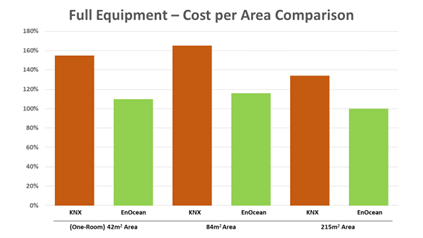Smart work environments for SMEs
Wired or wireless technology: Which is better for smart buildings?
Smart spaces with demand-driven regulation of temperature, air quality, and lighting can significantly enhance employee comfort and well-being, boosting both motivation and productivity. What large enterprises achieve in their smart spaces is increasingly accessible to smaller businesses as well. However, hardware alone doesn’t make a space smart; the key lies in the type of networking—whether wired or wireless. A recent study by Rosenheim Technical University of Applied Sciences compares the KNX and EnOcean standards across various scenarios, offering insights that are applicable to smart buildings of all sizes.
When people feel comfortable, they are more committed and productive. This connection is well understood by many large companies, which rely on smart spaces and sensor-based infrastructure management. These systems collect sensor-generated data on building conditions, using it for adjustments or analysis. Important factors such as temperature, air quality, lighting, and cleanliness can be monitored and controlled based on the number of occupants. Thus, smart spaces serve as an interface between people and their work environment, adding a virtual layer to the physical workspace.
The innovations being deployed on a large scale can also be realized on a smaller scale. For SMEs, the first steps toward smart buildings can involve implementing smart building functionalities that are easy to install or retrofit, upgrading offices, commercial spaces, or practices.
Different standards for smart spaces
Digital networking is essential for smart buildings, as it enables seamless communication between individual components. This can be achieved either through wired or wireless technology. Both options have open standards in addition to proprietary solutions from individual manufacturers. KNX (wired) and EnOcean (wireless) are leading standards in their respective categories.
KNX (Konnex) is a widely used wired bus system for building automation. Evolved from the European Installation Bus (EIB), KNX is an open, manufacturer-independent standard supported by many companies. As a standardized system, KNX offers considerable flexibility and is known for its security.
EnOcean, defined by the International Electrotechnical Commission (IEC) in 2012 as a global wireless standard (ISO / IEC 14543-3-10), is used in decentralized building automation. Over a million smart buildings worldwide utilize such radio networks. The EnOcean ecosystem comprises self-powered wireless sensor solutions, with 5,000 product variants based on 1,500 core products. These can be combined through standardized interoperable sensor profiles.
Wired or wireless technology in smart spaces?
This is the central question addressed in a study[1] by Julia Winkler (B.Eng.) and Prof. Dr. Michael Krödel. The study compares smart spaces of varying sizes based on KNX or EnOcean technology across two equipment variants, focusing on costs, sustainability, health, and well-being. In each scenario, a conventional building without smart networking serves as a benchmark.
Specifically, the study covers:
- A single-room area of 42.3 m² with 33 or 42 components (basic or full equipment)
- A medium-sized area of 83.5 m² with 70 or 89 components
- A large area of 215.2 m² with 162 or 186 components
The equipment in conventional buildings adheres to the DIN 18015-RAL-RG678 standard for the installation of electrical systems in residential structures. The differentiation of smart building variants stems from internal university research. The basic setup includes entry-level functionalities for comfort, safety, and energy conservation, while the full setup adds advanced lighting, heating, and security features. The cost calculations for each variant are based on a pricing guide for electrical and IT trades, as well as current product catalogs from leading providers like Hager (for KNX) and Eltako (for EnOcean).
Smart costs – Wireless solutions are more cost-effective
A comparison between conventional installations and smart setups reveals a predictable outcome: Smart solutions are initially more expensive. According to the study, the extra cost for electrical installations ranges from 64% in a single-room area with basic EnOcean equipment to 385% in a medium-sized area with KNX[2].
When comparing wired (KNX) and wireless (EnOcean) options, wireless solutions are generally more cost-effective. The difference is 20 to 30 percent for comparable functionalities, due to the higher costs associated with cabling and installation.

On the other hand, maintenance-free wireless sensors do not require mains power or batteries. Leveraging energy harvesting technology, they draw energy from the environment (e.g., kinetic energy, pressure, light, and temperature differences). Wireless sensors can be installed wherever needed, saving time and money in both installation and operation. They also facilitate quick and easy retrofitting in existing buildings.
Conclusion
While smart spaces and their intelligent networking initially require higher investment, these costs pay off in the medium to long term, even for SMEs. Benefits include increased comfort and well-being, along with reduced energy costs. The installation costs for wireless smart offices can be up to a third lower than those for wired versions, and they also excel in flexibility and environmental sustainability.
The investment needed to deploy energy-efficient solutions in a smart building is just 10% of what is required for insulation but results in 25% immediate energy savings. Deployed on a large scale, this will support insulation efforts while creating a smart network for multiple services, including high-speed Internet, now considered essential like water or electricity—this is the essence of a Building 4.0.
[1] Winkler, J. (2021). Comparison of KNX and EnOcean using room automation installations as examples with regard to costs and ecological aspects as well as taking into account a user-oriented requirements profile. (Bachelor thesis). Rosenheim Technical University of Applied Sciences, Germany.
[2] Overall, it should be noted that all KNX variants incur costs for Engineering Tool Software (ETS) and license fees in addition to materials and installation.


